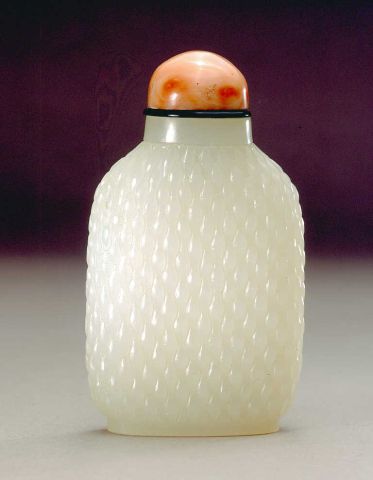
Bottle ID: 278
CARVED, BASKET WEAVE
Date: 1750-1800
Height: 62 mm
Nephrite, well hollowed, of flattened rectangular form with sloping shoulders, the even white stone continuously carved in low relief with a basket-weave design, the neck and foot left uncarved.
Imperial, attributed to the Palace Workshops, Beijing.
Similar Examples:
Crane Collection no. 654
Moss, Hugh, Victor Graham and Ka Bo Tsang. The Art of the Chinese Snuff Bottle - The J & J Collection, 1993, Vol. I, p. 109, no. 50.
Hughes, Michael C. The Blair Bequest - Chinese Snuff Bottles from the Princeton University Art Museum, 2002, p. 41, no. 6.
Low, Denis S. K. More Treasures from the Sanctum of Enlightened Respect, 2002, p. 42, no. 36.
Provenance:
Clare Lawrence Ltd.
Alexander Brody
Clare Lawrence Ltd.
Joseph Baruch Silver
John Ford Associates
Edward Choate O'Dell
H. J. Heinz, Chicago
Exhibited:
Honolulu Academy of Arts, Honolulu, Hawaii, November 23, 1989 - January 7, 1990
Israel Museum, Jerusalem, Israel, December 31, 1987 - June 25, 1988
Published:
Lawrence, Clare. The Alexander Brody Collection of Chinese Snuff Bottles, 1995, p. 15, no. 12
Brody, Alexander. Old Wine into Old Bottles. A Collector's Commonplace Book, 1993, pp.22 and 148
Chinese Snuff Bottles from the Collection of Joseph Baruch Silver in Conjunction with the Exhibition at The Israel Museum, Jerusalem, Winter 1987, p. 27, no. 44
The basket-weave design is a popular one on snuff bottles. Its inspiration seems to come from woven baskets which were used as functional containers for a variety of purposes, throughout history. A woven cover for containers, with harder or more brittle surfaces, such as pottery, was also used presumably for insulation and protection, especially when travelling. The pattern is sometimes described as a stylized rice-grain pattern, but despite the huge amounts of rice eaten by the Chinese this is unlikely.
< Back to full list

 English
English 中文
中文